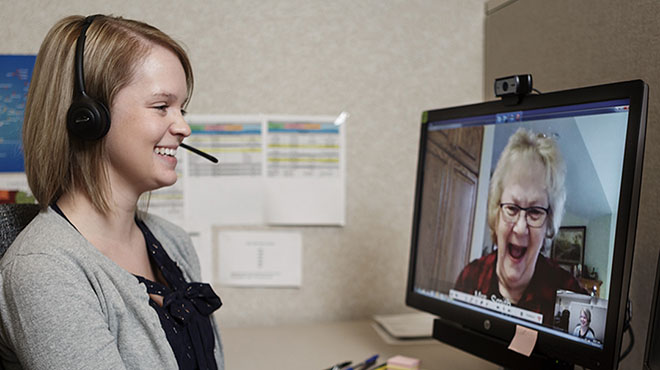Recent Posts
-
 Patient StoriesA lifesaver saved: An EMS veteran’s journey from rescue to recoveryNovember 14, 2025
Patient StoriesA lifesaver saved: An EMS veteran’s journey from rescue to recoveryNovember 14, 2025 -

-

Video visits keep patient, doctor connected during pandemic

Nov. 1, 2019, is a day that Debbie Doble will always remember. That's the day she received news that would change her life: She had breast cancer.
After a routine mammogram showed signs of cancer, Debbie, a 59-year-old Spooner, Wisconsin, resident, was referred to Eyad Al-Hattab, M.D., an oncologist at Mayo Clinic Health System. Her first visit was 1 hour and 20 minutes from her home in the Albert J. and Judith A. Dunlap Cancer Center at Mayo Clinic Health System in Eau Claire where Dr. Al-Hattab explained her treatment plan and answered her questions. Debbie would undergo four rounds of chemotherapy followed by 21 radiation treatments.
Debbie's next appointment with Dr. Al-Hattab was at Mayo Clinic Health System – Northland in Barron — only 35 minutes from her home — and her chemotherapy treatments also began in Barron.
Then the COVID-19 pandemic began, and many face-to-face clinic appointments were deferred. But Debbie's care team had a new plan: video visits using telehealth technology.
"Video visits connect the care team to the patient in the comfort of their homes," says Dr. Al-Hattab. "For the most part, the video visit software is easy to use. It works the exact same way as other video chat software, like Zoom, Facebook Messenger and Facetime."
When presented with this option, Debbie was thrilled.
"Honestly, I thought it was fabulous," says Debbie. "When you live in God's country, you get used to driving everywhere. This brought my doctor to me."
Debbie's next three appointments were conducted using telehealth technology. For years, Mayo Clinic has used telehealth technology to connect patients with specialists at Mayo Clinic in Rochester. With the social distancing and stay-at-home guidelines of the COVID-19 pandemic, telehealth use has grown to help connect thousands of patients like Debbie to their care teams.
Patients need to have a Patient Online Services account to take advantage of video visits. Debbie set up her account during her first clinic appointment with Dr. Al-Hattab.
"We could easily communicate over the video conference," says Debbie. "During one visit, my doctor brought up my file on his computer so I could see it clearly. It was wonderful. I would highly recommend it. It saves on my time, and I'm sure it saves on the doctor's time also."
Another advantage is that family members and caregivers can remotely participate in the same visit while not in the same location.
"Video visits gives everyone involved in the patient's care the opportunity to see me and the patient while we review scans and lab results through a shared screen," says Dr. Al-Hattab.
At the end of April, Debbie completed her chemotherapy treatments.
"I'm glad to finally be done and moving on to the next steps," she says. "Chemo took a long time and had a lot of side effects. You don't know from day to day how you are going to feel."
Thankfully, she has a good support team on her side.
"My co-workers have been supportive," says Debbie. "When I'm at work, they take extra steps to keep me safe from COVID-19."
Dr. Al-Hattab says he is happy that video visits enable him to continue to provide care to patients during the COVID-19 pandemic and believes the number of video visits will grow in the future.
"They can be extremely helpful even in situations that we do not have pandemic," says Dr. Al-Hattab. "Sometimes we have referrals that need to be accelerated. I see that we may use visual visits with patients who live in remote areas, like Ms. Doble, to explain the need for additional steps or tests. I think it is going to be part of the future. This type of technology will allow us to reach more patients across the globe and share Mayo Clinic's expertise in health care."



